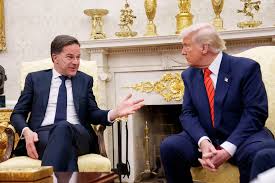NATO leaders, including U.S. President Donald Trump and UK Prime Minister Keir Starmer, are meeting this week to consider a major hike in defence spending across the alliance, despite the fact that nearly one-third of member states still fall short of the existing 2% of GDP target.
A new proposal, unveiled at the NATO summit, calls for member countries to allocate 5% of their economies to “core defence” and related security initiatives—a dramatic escalation intended to bolster the alliance’s strength in the face of rising geopolitical threats, especially from Russia.
However, according to the latest NATO data, nine member nations have yet to meet the current 2% benchmark. Spain remains the lowest spender, with defence expenditure at just 1.2% of GDP in 2024.
President Trump, a long-time critic of NATO allies’ defence budgets, singled out Spain as “notorious” for under-spending. He has previously threatened to withhold U.S. support from allies who do not meet the target, saying he would even “encourage” adversaries to act accordingly.
The disparity in spending is not only financial but also geographical, according to defence analysts. Rachel Ellehuus, director at the UK-based Royal United Services Institute (RUSI), pointed out that NATO countries closest to Russia—mainly in the alliance’s north and east—have significantly increased their defence budgets, while southern members have lagged behind.
“The allies who feel the most immediate threat from Russia are those investing more,” Ellehuus explained.
While the 2% target remains non-binding, political pressure—particularly from Washington—has had a measurable impact. “Nobody wants to be called a bad ally,” said Jamie Shea, a former NATO official.
Collectively, NATO countries (excluding the U.S.) have increased their average defence spending from 1.4% of GDP in 2014 to 2% in 2024. Every member has raised its budget over the past decade.
Spain’s Prime Minister Pedro Sánchez has pledged to reach the 2% target by 2025 and even suggested that Spain could hit 2.1% before the end of 2024. However, Sánchez argued that the proposed 5% goal is “incompatible with our worldview” and claims to have negotiated an exemption. Spanish officials emphasized the need for strategic, efficient defence investments rather than simply boosting raw expenditure.
“We didn’t see the need for large armed forces, instead focusing on disaster response,” said Mario Saavedra, diplomatic correspondent for El Periódico. “But things are changing very fast.”
Other NATO members have also made new commitments:
- Canada aims to reach 2% by March 2025, up from 1.5% in 2024.
- Belgium plans to invest an additional €4 billion this year to move from 1.3% to 2%.
- Portugal now expects to meet the 2% goal in 2024, four years ahead of schedule.
- Italy is on track to hit 2% in 2024, up from 1.5% the previous year.
Trump has repeatedly claimed credit for rising defence budgets within NATO. Secretary-General Mark Rutte acknowledged the former president’s role, a comment Trump highlighted on his Truth Social platform, writing: “Europe is going to pay in a BIG way, as they should, and it will be your win.”
The U.S. continues to be NATO’s largest contributor, spending $935 billion in 2024—equivalent to 3.2% of its GDP and more than all other members combined. Among European nations, Poland leads with 4.1%, followed by Estonia and Latvia at 3.4% each.
As NATO seeks to reinforce unity amid global instability, the debate over spending levels and timelines continues to test the alliance’s cohesion.









